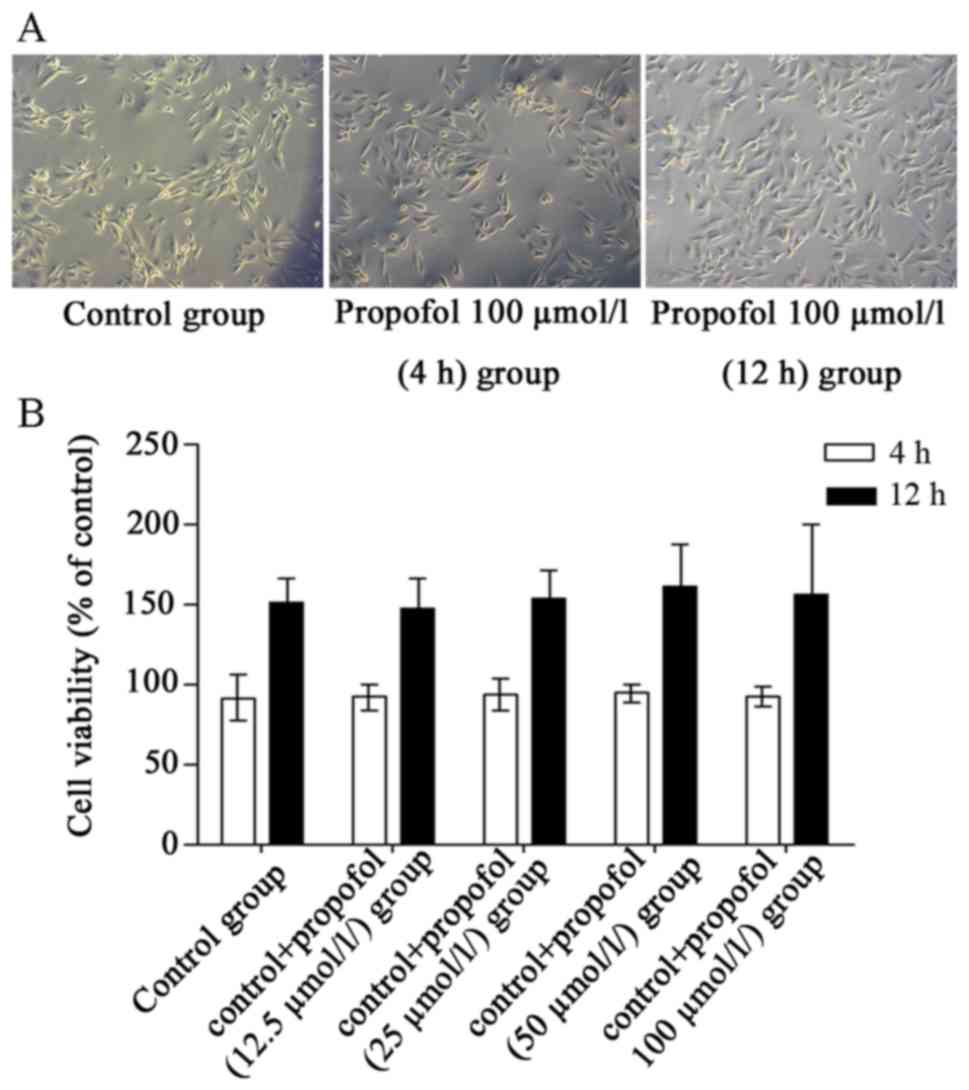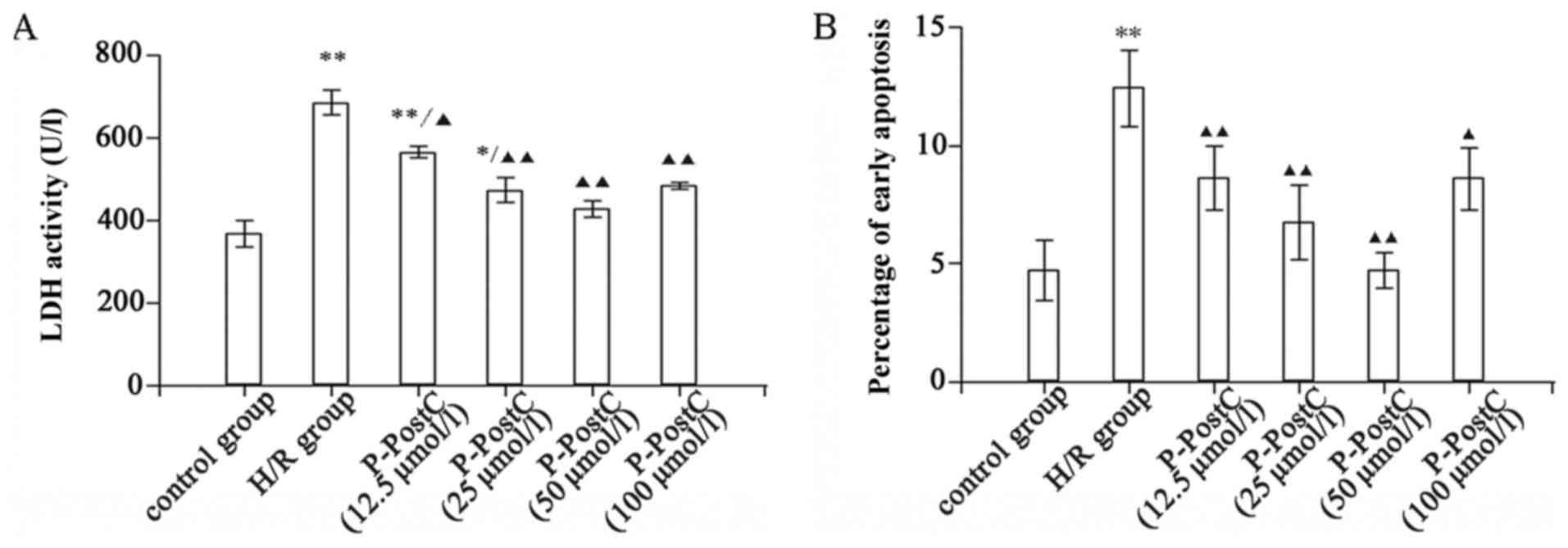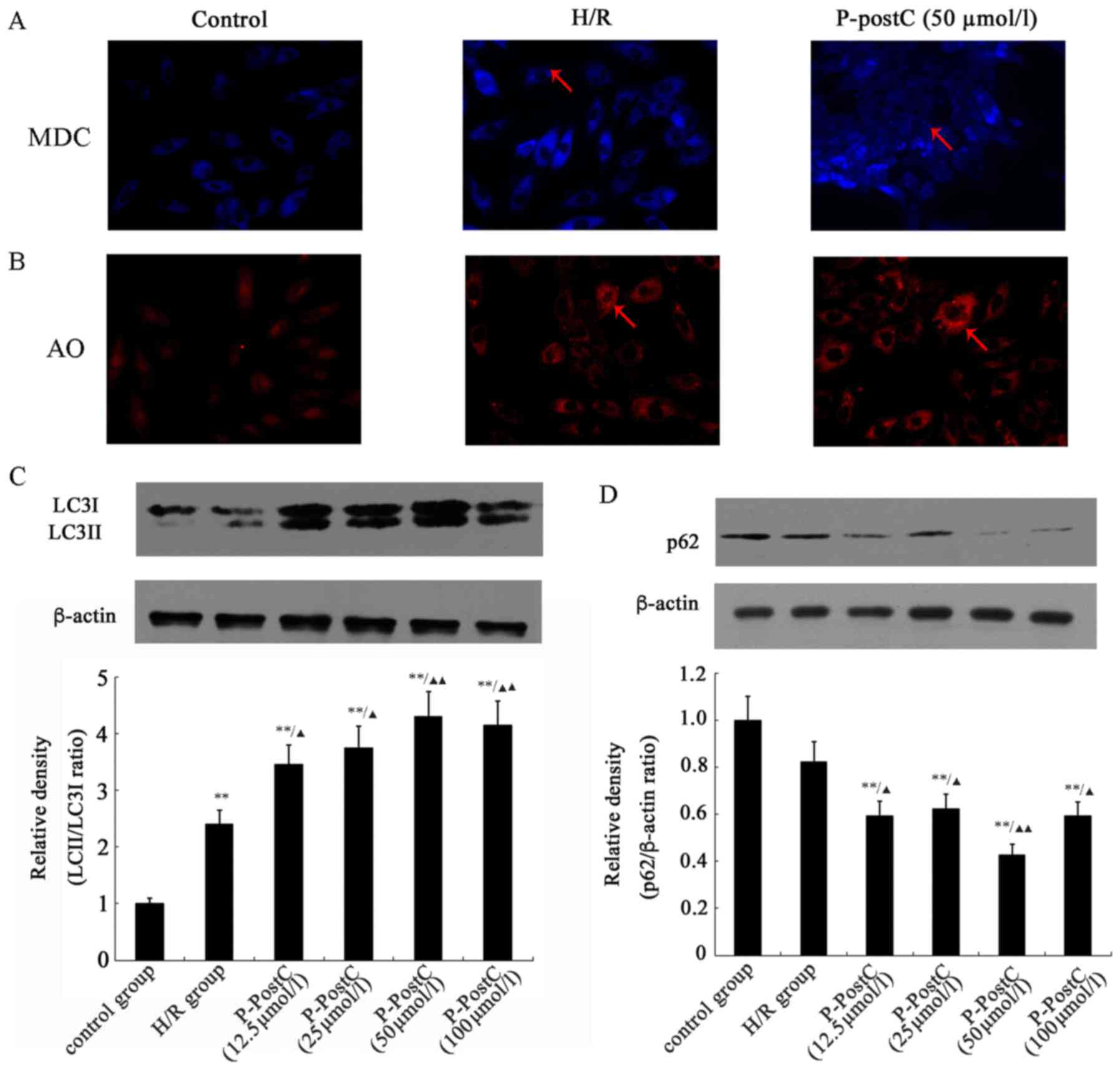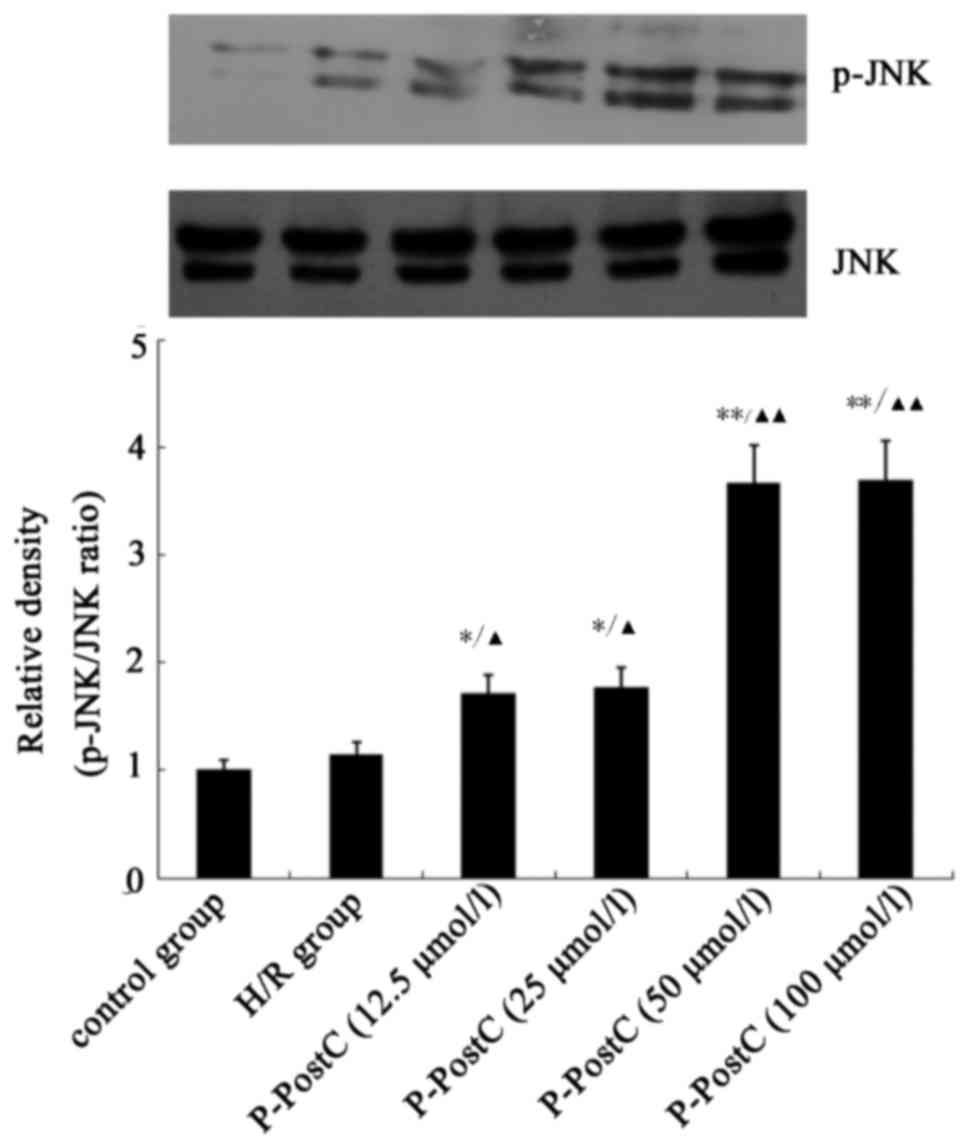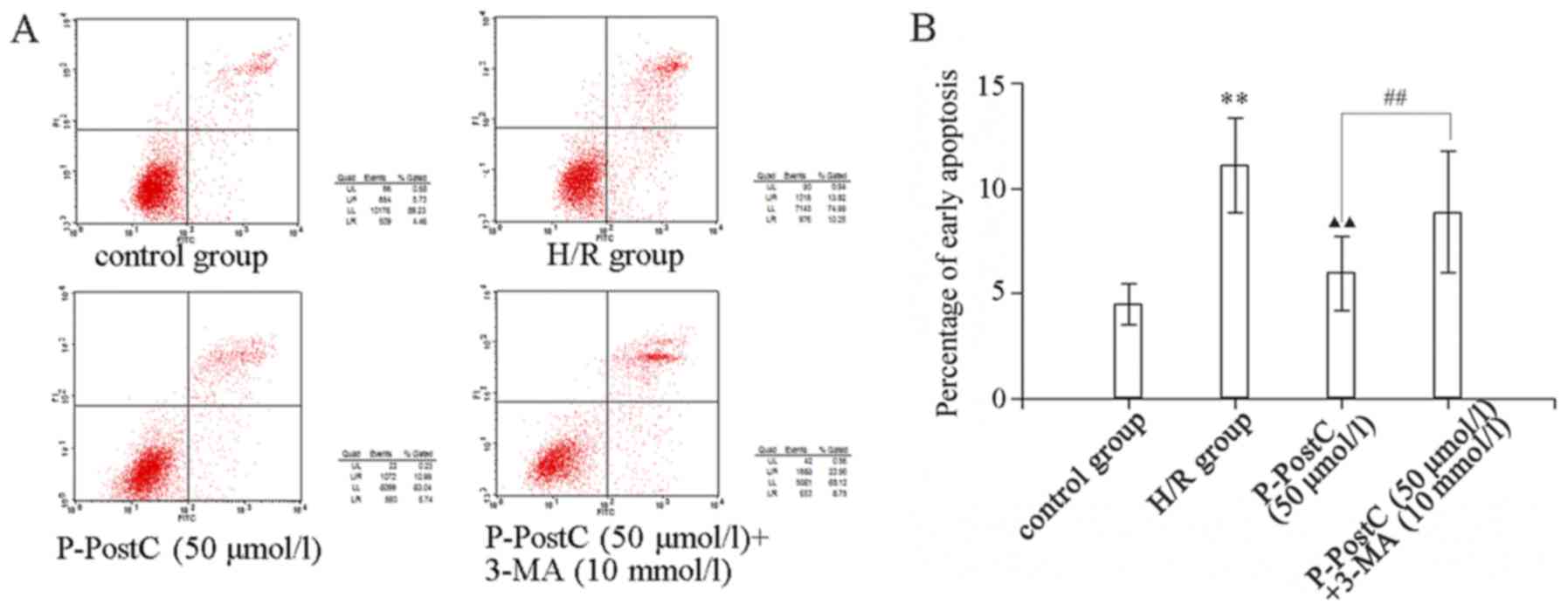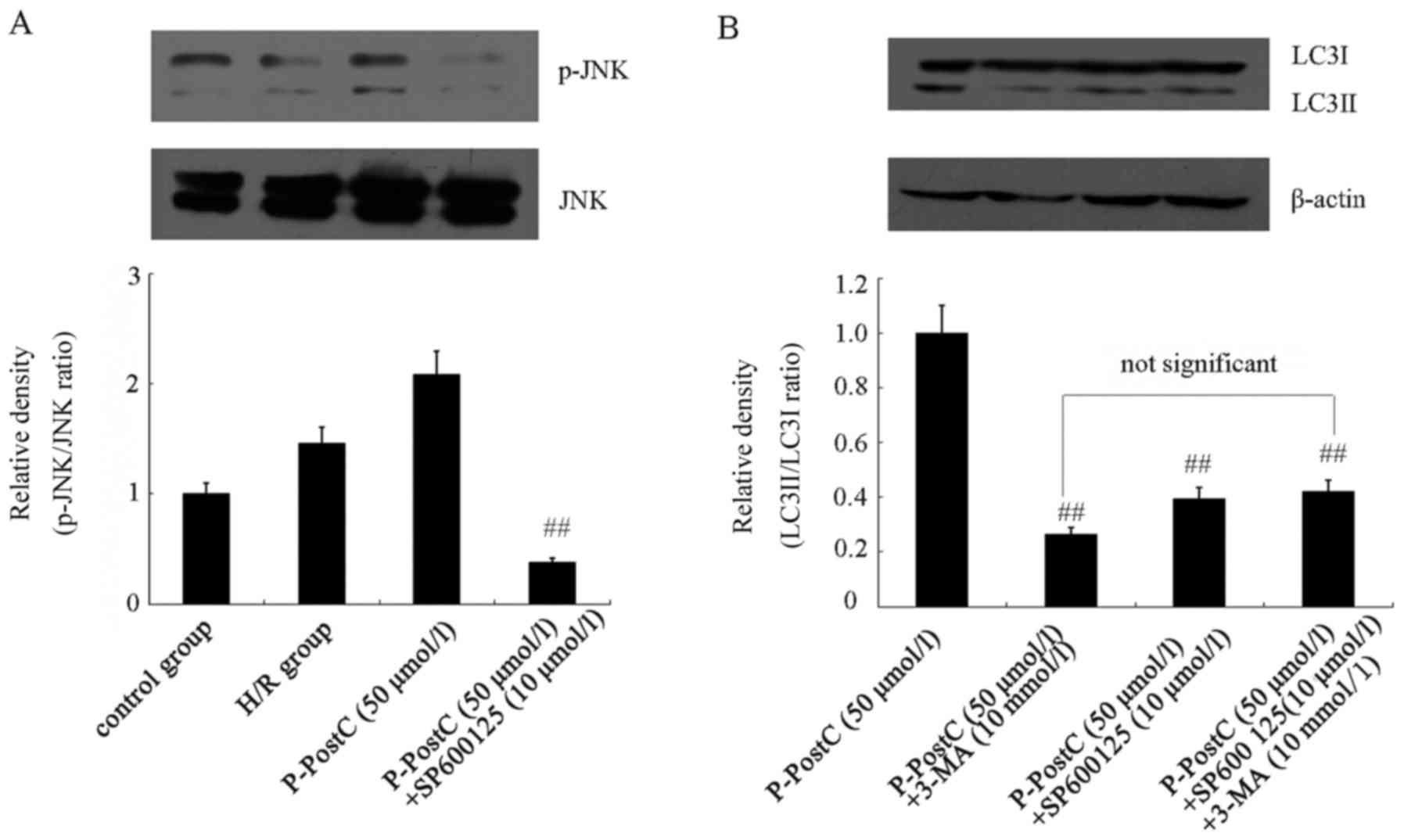Propofol postconditioning protects H9c2 cells from hypoxia/reoxygenation injury by inducing autophagy via the SAPK/JNK pathway
- Authors:
- Published online on: January 11, 2018 https://doi.org/10.3892/mmr.2018.8424
- Pages: 4573-4580
Abstract
Introduction
Perioperative myocardial ischemia is a common condition associated with high mortality (1). Removal of the occlusion and reperfusion of the ischemic area promotes additional cardiac injury that exacerbates the process of infarction. This phenomenon is termed ischemia/reperfusion (I/R) injury. Ischemic preconditioning was first identified in 1986 by Murry as a phenomenon in which repeated short episodes of ischemia protect the myocardium against a subsequent I/R injury (2). However, clinical application was unsatisfactory for the unpredictability of ischemia. Ischemic postconditioning, a novel cardioprotective intervention against I/R injury is performed following ischemia, may offer a solution to this problem (3). In addition, a number of different pharmacological agents have been reported to mimic ischemic postconditioning to achieve cardioprotection (4,5).
Propofol is a widely used intravenous agent for the induction and maintenance of anesthesia (6). Our previous study revealed that propofol postconditioning (P-PostC) had protective effects against hypoxia/reoxygenation (H/R)-induced apoptosis in cardiomyocytes (7). However, the mechanism by which P-PostC functions against I/R injury requires further investigation. Autophagy is an evolutionarily conserved protein degradation pathway that is essential for the intracellular homeostasis between biosynthesis and catabolism (8,9). In terminally differentiated cells, such as cardiomyocytes, autophagy may serve an important role in cellular self-protection, facilitating survival under stress (10). An increasing number of studies have demonstrated that autophagy may be necessary for cardioprotection conferred by preconditioning (11,12); the mechanism may be associated with the upregulation of endogenous protective mechanisms against myocardial I/R injury (13). The c-Jun NH2-terminal kinases (JNK) were initially identified as the stress-activated protein kinases (SAPK) which are activated by a number of stressors including I/R injury and serve an important role in multiple stimulation-induced autophagic events. Recent studies proved that JNK signal pathway participated in the induction of p62 expression and its binding to microtubule-associated protein 1A/1B-light chain 3 (LC3) (14). LC3 is an important protein involved in autophagy, LC3-I is conjugated to phosphatidylethanolamine to form LC3-II which is recruited to autophagosomal membranes (15). p62 (also known as sequestosome 1) is a ubiquitin- and LC3-binding protein involved in cell autophagy; the induction of autophagy is accompanied by p62 protein degradation (16).
The present study hypothesized that propofol may induce autophagy to protect the myocardium. To test this hypothesis, the effects of P-PostC at various doses on the induction of autophagy and the potential regulatory mechanisms were investigated using an in vitro H/R model using rat heart-derived H9c2 cells.
Materials and methods
Reagents
Propofol, 3-methyladenine (3-MA), acridine orange (AO), monodansylcadaverine (MDC) and the c-Jun N-terminal kinase (JNK) inhibitor SP600125 were purchased from Sigma-Aldrich (Merck KGaA, Darmstadt, Germany) and were dissolved in dimethyl sulfoxide (DMSO), and further diluted in PBS. The final DMSO concentration was 0.1%, which did not affect cell function and the assay system. Fetal bovine serum (FBS) and Dulbecco's modified Eagle's medium (DMEM) were purchased from Gibco (Thermo Fisher Scientific, Inc., Waltham, MA, USA). Primary antibodies used in the study included: Rabbit anti-microtubule-associated protein 1A/1B-light chain 3B (LC3B; cat. no. L7543; Sigma-Aldrich; Merck KGaA) and rabbit anti-p62 (cat. no. P0067; Sigma-Aldrich; Merck KGaA); rabbit anti-stress-activated protein kinase (SAPK)/JNK (cat. no. 9252; Cell Signaling Technologies, Danvers, MA, USA) and rabbit anti-phosphorylated (p)-SAPK/JNK (cat. no. 4668; Cell Signaling Technologies) and mouse anti-β-actin (cat. no. sc130301; Santa Cruz Biotechnology, Dallas TX, USA). Secondary antibodies included horseradish peroxidase-conjugated goat anti-mouse (cat. no. sc2031; Santa Cruz Biotechnology) and goat anti-rabbit immunoglobulin G (cat. no. sc2007; Santa Cruz Biotechnology).
Cell line and culture conditions
The H9c2 embryonal rat heart-derived (cardiac muscle) cell line was obtained from the American Type Culture Collection (Manassas, VA, USA) and cultured in DMEM containing 4.5 g/l D-glucose, 1.5 g/l sodium bicarbonate and 110 mg/l sodium pyruvate, supplemented with 10% FBS, penicillin (100 U/ml) and streptomycin (100 Ag/ml), in a humidified incubator with 95% air and 5% CO2 at 37°C.
H/R model and experimental groups
Hypoxia was established in Modular Incubator Chambers (Billups-Rothenberg, Inc., Del Mar, CA, USA); the chambers were flushed with a gas mixture of 95% N2 and 5% CO2 at room temperature for 30 min at 10 l/min. Following flushing, the chambers were sealed and maintained at 37°C for 6 h. The concentration of O2 in each chamber was monitored with an oxygen indicator (Mitsubishi Gas Chemical Company, Inc., Tokyo, Japan). Hypoxia was terminated by exposing the cells to fresh DMEM containing 10% FBS and incubating them in a normal incubator (95% air; 5% CO2) for 4 h at 37°C to simulate reperfusion (reoxygenation). Propofol of concentrations between 12.5–100 µmol/l was added into the fresh medium at the commencement of reperfusion/reoxygenation. SP600125 and 3-MA treatments were administered at a final concentration of 10 µmol/l and 10 mmol/l, respectively, according to previously published methods (17,18), for 1 h prior to hypoxia exposure. The cells were trypsinized with 0.25% trypsin at 37°C, harvested at the centrifugation at 800 × g for 3 min at room temperature and washed twice with PBS at the end of reoxygenation.
H9c2 cells were separated into the following experimental groups: i) Control group of normally cultured H9c2 cells; ii) H/R group, which were subjected to H/R; iii) P-PostC group, which received propofol treatment upon H/R; iv) P-PostC + SP600125 group, which received SP600125 and P-PostC co-treatment upon H/R (group); v) P-PostC+3-MA group, which were subjected to 3-MA and P-PostC co-treatment under H/R; vi) P-PostC + 3-MA + SP600125 group, which received 3-MA, SP600125 and P-PostC co-treatment upon H/R; vii) vehicle-treated group, which were H9c2 cells normally cultured with 0.1% DMSO in the culture medium; and viii) propofol-treated group, which comprised vehicle-treated cells subjected to propofol administration without H/R.
Assessment of lactate dehydrogenase (LDH) activity and cell viability in culture medium
To measure the extent of cell injury, the LDH activity was analyzed. Cells were plated in a 6-well plate at a density of 5×105 cells/well. At the end of the reoxygenation, the supernatants were collected. The LDH assay kit (A020-1; Jiancheng Bioengineering Institute, Nanjing, China) was employed according to the manufacturer's protocols. Briefly, 0.1 ml culture medium was added into 3 ml LDH assay reaction mixture. After 3 min incubation at 37°C, the optical density was measured at a wavelength of 440 nm using a spectrophotometer. H9c2 cell viability in the different treatment groups was analyzed by MTT assay. Cells were plated at 1×104 cells/well in 96-well microtiter plates. Each group was repeated in 10 wells. Following treatment, MTT (5 mg/ml in PBS) was added to each well and incubated for 3 h at 37°C. After careful removal of the medium, the formazan crystals were dissolved in 200 µl DMSO and absorbance (A) values were determined at 570 nm using a microplate reader (Model 550; Bio-Rad Laboratories, Inc., Hercules, CA, USA) within 30 min following the dissolution of the formazan crystals.
Detection of myocyte apoptosis
Following treatment, myocytes were harvested with 0.25% trypsin and subjected to apoptosis analysis using an Annexin V-fluorescein isothiocyanate (FITC) detection kit (Beyotime Institute of Biotechnology, Haimen, China). Subsequently, the cell density was adjusted to 1×106 cells/ml, 5 µl Annexin V-FITC and 10 µl propidium iodide (PI) (1 µg/ml) were then added to these cells and incubated for 10–20 min at room temperature (20–25°C) in the dark. The rate of apoptosis was then analyzed with a FACScalibur flow cytometer and calculated by CellQuest software (Becton Dickinson, Franklin Lakes, NJ, USA). Early apoptotic cells were positive for Annexin V-FITC and negative for PI.
MDC and AO staining of autophagosomes
H9c2 cells were seeded at a density of 1×104 cells/well onto coverslips fixed in culture dishes and allowed to reach 70–80% confluence. MDC, a selective fluorescent marker preferentially accumulates in autophagic vacuoles, exhibits alterations in fluorescence that can be observed using a fluorescence microscope. Autophagy is characterized by increased formation of lysosomes and autophagolysosomes which can be stained with AO. Following H/R and P-PostC, cells were incubated with 0.05 mmol/l MDC or 1 mg/ml AO for 15 min, fixed with 3.7% paraformaldehyde in PBS for 30 min at 37°C, rinsed with PBS and dried. Cells were observed under an IX70 fluorescence microscope (Olympus Corporation, Tokyo, Japan) equipped with a filter system: MDC, excitation wavelength, 380 nm and emission filter, 525 nm; AO, excitation wavelength, 488 nm and emission filter, 525 nm. Five randomly selected fields were observed per slide. Data were obtained from ≥3 independent experiments.
Protein lysate preparation, electrophoresis and immunoblot analysis
H9c2 cells were plated at a density of 1×106 cells/well in 6-well culture dishes. Following treatment, cells were washed with PBS and lysed on ice for 30 min in radioimmunoprecipitation assay buffer containing 50 mM Tris HCl (pH 7.5), 250 mM NaCl, 1 mM EDTA, 1 mM EGTA, 1 mM NaF, 1 mM PMSF, 1 mM DTT, 1 µg/ml leupeptin, 1 µg/ml aprotinin and 1 µg/ml pepstatin (Sigma-Aldrich, Merck KGaA). Cell lysates were then centrifuged at 13,000 × g for 10 min at 4°C, and protein concentrations were assayed using a Bicinchoninic Acid assay kit (Beyotime Institute of Biotechnology). Protein samples were separated by 12% SDS-PAGE and transferred to nitrocellulose membranes using an electro-blotting apparatus (Bio-Rad Laboratories, Inc.). The membrane was blocked with 5% nonfat milk in TBST solution, and incubated overnight with primary antibodies (anti-LC3B, 1:1,000; anti-p62, 1:1,000; anti-JNK, 1:1,000; anti-p-JNK, 1:1,000 and anti-β-actin, 1:500) in the blocking solution at 4°C. After three washes with TBST solution, the membrane was incubated at room temperature for 1 h, with horseradish peroxidase-conjugated secondary antibody diluted with TBST solution (1:3,000). The signals of detected proteins were visualized by an enhanced chemiluminescence reaction (ECL) system (Amersham, ECL kits). For semi-quantitative analysis, protein bands detected by ECL were scanned into Adobe Photoshop CS6 (Adobe Systems, Inc., San Jose, CA, USA) and analyzed using ImageJ software, version 1.6 (National Institutes of Health, Bethesda, MD, USA).
Statistical analysis
Data are reported as the mean ± standard deviation, and statistical significance was assessed using SPSS 18.0 software (SPSS, Inc., Chicago, IL, USA). Differences between groups were evaluated with analysis of variance (ANOVA) followed by a Bonferroni's post hoc test for multiple comparisons. Prior to ANOVA, Levene's test for equality of variances was performed; data were confirmed to be normally distributed. P<0.05 was considered to indicate a statistically significant difference.
Results
Propofol treatment alone exhibits no effects on the survival and proliferation of cultured H9c2 cells
To exclude possible interference by using animals, a heart-derived H9c2 cell line for in vitro observation was used in the present study. H9c2 cells have been extensively used in cardiological research, as they possess elements and properties of the signaling pathways of adult myocytes (19), thus offering a suitable in vitro experimental H/R model. To examine whether propofol treatment alone affected the viability of cultured cardiomyocytes, morphological observations and MTT cell viability assays were performed, following treatment with propofol for 4 and 12 h. Vehicle-treated cells (4 h) were considered to be 100% viable, the viability of vehicle-treated cells (12 h) was 150% compared with Vehicle-treated cells (4 h). No notable morphological alterations were observed in propofol-treated cells (Fig. 1A) and no significant differences in cell viability were detected (P>0.05; Fig. 1B) compared with the vehicle-treated group.
P-PostC protects H9c2 cells against H/R injury by reducing LDH levels and the number of apoptotic cells
Cellular damage was assessed by measuring the activity levels of the cytosolic enzyme LDH released into the medium, induced by cell membrane leakage (20). Following H/R exposure, cells exhibited a significant increase in LDH activity in the culture medium, 1.9-fold of the level in the control group (Fig. 2A). This increase was significantly reduced by P-PostC treatments at various concentrations (P<0.01 vs. H/R; Fig. 2A). The cardioprotection of P-PostC against H/R injury was further examined by determining the rate of cardiomyocyte apoptosis. The percentage of early apoptotic cells in the untreated control and H/R groups were 4.72±1.3 and 12.45±1.6%, respectively (P<0.05). The proportion of Annexin V-FITC-stained cells in the 12.5–50 µmol/l P-PostC-treated groups decreased significantly and in a dose-dependent manner, compared with the H/R group (Fig. 2B) There was a marked reduction in the number of early apoptotic cells, ranging between 4.7±0.8 and 8.6±1.3%, with different concentrations (12.5–50 µmol/l) of propofol compared with H/R. This indicated that 12.5–50 µmol/l P-PostC conferred dose-dependent protection against H/R injury to cardiomyocytes. However, the percentage of early apoptotic cells in the 100 µmol/l P-PostC group was 8.5±1.1%, compared with in the 50 µmol/l P-PostC-treated group (4.7±0.8%, P<0.05); the optimal concentration of propofol for P-PostC was demonstrated to be 50 µmol/l. P-PostC (12.5–50 µmol/l) protected the H/R cardiomyocytes from apoptosis, whereas propofol concentrations >100 µmol/l exhibited less positive effects on cell apoptosis. These data were consistent with a previous study and may be due to the known inhibitory effect of calcium channels at high concentrations (21).
P-PostC induces autophagy in H9c2 cardiac cells
The fluorescent dye MDC is an autofluorescent marker that accumulates in autophagic vacuoles, and is used to detect autophagic vesicle formation (22). Autophagy was induced by incubating H9c2 cells for 6 h in hypoxic conditions followed by 4 h of reoxygenation. The level of autophagic vacuole formation was evaluated by staining the cells with MDC. The results demonstrated that autophagosome formation was enhanced under H/R conditions (Fig. 3A), and P-PostC (50 µmol/l) further induced autophagy compared with untreated control cells. Fluorescence microscopic analysis identified MDC-positive structures in the H/R and P-PostC groups, particularly in the P-PostC group, whereas MDC-labeled structures were almost undetectable in normal cells. In addition, the acidic vesicular organelles in cells were also stained with AO. Fluorescence microscopic analysis demonstrated that the H/R and P-PostC treated cells exhibited abundant cytoplasmic acidic vesicular organelle formation, compared with the Control group (Fig. 3B).
The induction of autophagy was confirmed by detecting increased protein expression of LC3-II and the enhanced ratio of LC3-II/LC3-I expression. LC3-II expression was enhanced in H9c2 cells in the H/R group (Fig. 3C), and preconditioning with different concentrations of propofol (12.5–100 µmol/l) significantly increased the expression of LC3-II in a dose-dependent manner, compared with expression in the H/R group (Fig. 3C). The levels of p62 expression in H9c2 cells were reduced following H/R exposure and decreased in response to P-PostC. Accompanied by increased LC3 lipidation, the steady-state levels of p62 were reduced following H/R exposure and P-PostC, which confirmed the autophagy within H9c2 cells (Fig. 3D).
P-PostC activates phosphorylation of JNK
To study the role of the SAPK/JNK signaling pathway in P-PostC-induced autophagy, the activation of JNK in the H/R and H/R + P-PostC groups was detected by western blotting (Fig. 4). H/R exposure slightly increased JNK phosphorylation compared with in control; Fig. 4, and P-PostC co-treatment further enhanced the phosphorylation of JNK (P<0.05 vs. H/R; Fig. 4).
P-PostC mediated-autophagic induction is negatively associated with the induction of apoptosis
As presented in Fig. 5, H/R induced the apoptosis of cardiomyocytes compared with in the control group, while P-PostC (50 µmol/l) markedly reduced the percentage of apoptosis. To investigate the association between the apoptosis and autophagy induced in the myocardiocytes, cells of the P-PostC+3-MA group were pre-treated with the autophagy inhibitor 3-MA (10 mmol/1) for 1 h prior to hypoxia, and then treated with H/R and P-PostC (50 µmol/l). The results revealed that pre-treatment with 3-MA markedly increased the percentage of apoptotic cells compared with the P-PostC (50 µmol/l) group (P<0.01 vs. P-PostC 50 µmol/l; Fig. 5). As autophagy was inhibited in the 3-MA-treated cardiomyocytes, the cardioprotection of P-PostC (50 µmol/l) was also eliminated.
Activation of JNK is required for P-PostC-induced autophagy
To further investigate the role of JNK in P-PostC-mediated autophagy, cells were pretreated with 10 µmol/l SP600125, a JNK activity-specific inhibitor, for 1 h, followed by exposure to H/R or P-PostC (50 µmol/l) treatment. SP600125 significantly eliminated the phosphorylation of JNK induced by P-PostC (50 µmol/l) on H/R cells (Fig. 6A). In addition, SP600125 could reverse the autophagy-induced protective effects of P-PostC (50 µmol/l). Compared with P-PostC treatment, pretreatment with SP600125 inhibited the increase of LC3-II induced by P-PostC (50 µmol/l; Fig. 6B) and had similar effects as the 3-MA pretreatment (Fig. 6B). These results indicated that the JNK-specific inhibitor could block autophagy induced by P-PostC in H9c2 cardiac cells.
Discussion
The present study demonstrated that P-PostC treatment significantly alleviated cardiomyocyte H/R injury and reduced the percentage of apoptotic cells induced by H/R, which was consistent with our previous study (7). Furthermore, the present results suggested that the cardioprotection of P-PostC may be conferred through autophagy enhancement activated by the SAPK/JNK signaling pathway in H/R injury.
Autophagy is a self-clearing process that removes damaged organelles and protein aggregates, which occurs at low basal levels under normal conditions in the myocardium; however, autophagy rapidly increases in response to stress conditions, such as ischemia or hypoxia (23). Enhanced autophagy is often observed in dying cardiac myocytes (24); however, the functional significance of autophagy under these conditions remains unclear. Previous studies have demonstrated that the upregulation of autophagy may protect cardiac cells against I/R injury and may also promote cell survival (25,26). As the cardioprotection of P-PostC treatment may be due to its ability to activate survival signaling pathways, the present study aimed to determine the ability of P-PostC to induce autophagy during simulated in vitro myocardial I/R injury, and to explore the signaling pathways that may be involved in this process. The results indicated that P-PostC treatment induced cardiac autophagy and generated survival signaling in H9c2 cardiac myoblast cells, and that the inhibition of autophagy diminished the cardioprotection of P-PostC. Furthermore, it was revealed that P-PostC treatment induced autophagy through the activation of SAPK/JNK survival signaling pathways to confer cardioprotection.
Previous studies on the underlying mechanisms of autophagy regulation in I/R injury have revealed that autophagy is regulated by multiple signaling pathways. However, the detailed mechanism by which I/R induces autophagy, as well as the direct targets of the autophagic signaling cascade, remained unknown. JNK as a ‘stress-responsive’ member of the mitogen-activated protein kinase family (27) was considered to serve a role in cardiomyocyte death, including apoptosis and autophagy, during I/R injury (28,29). A previous study reported that autophagy was inhibited in cells treated with a JNK inhibitor, indicating that the JNK pathway may be required to activate autophagy (30). Results from the present study demonstrated that P-PostC treatment was able to activate the JNK pathway and consequently mediate autophagy. It was also revealed that P-PostC co-treatment enhanced the phosphorylation levels of JNK in H9c2 cells. In addition, inhibition of the JNK signaling pathway by the specific inhibitor SP600125 was able to reverse the cardioprotective effects of P-PostC against H/R injury.
Apoptosis and autophagy are two types of programmed cell death (31); they are not always separate, and may be triggered by similar stimuli (32). A previous study presented conflicting views on the roles of autophagy in myocardial I/R injury; it was demonstrated that autophagy is enhanced during I/R (33). Another study reported that autophagy was an important element of the endogenous defense mechanisms activated by ischemic preconditioning (34). Consistent with this finding, the present results indicated that autophagy may alleviate the H/R injury and reduce apoptosis in the H/R model of H9c2 cells during P-PostC. By contrast, the pharmacological suppression of autophagy by 3-MA treatment increased the apoptotic rate in H/R exposed cells that were co-treated with P-PostC. Furthermore, SP600125 treatment effectively inhibited the phosphorylation of SAPK/JNK, and the induction of autophagy was also suppressed. These data indicated that the activation of autophagy may serve a crucial role in cardioprotection, and appears to be negatively correlated with the induction of apoptosis.
All data was obtained from in vitro experimentation; therefore, there are several limitations to the present study. H9c2 embryonal rat heart-derived cells were used in the H/R model. In contrast to the non-proliferating nature of primary cardiomyocytes, H9c2 cells are able to proliferate, but exhibit multiple similarities to primary cardiomyocytes including membrane morphology and electrophysiological properties; however in vivo studies are required further investigation within model animals. Transmission electron microscopy has been the gold standard to identify autophagosome formation, which is characterized by their double-membrane structure (35); however, owing to the limitations of experiment conditions and funding, transmission electron microscopy was not used in the present study. Alternative methods of detection, such as AO and MDC staining, the ratio of LC3-II/I and the expression of protein p62, were used to confirm autophagy.
In conclusion, the results of the present study indicated that P-PostC treatment promoted cell survival through the induction of autophagy in H9c2 cardiac myoblast cells, and that the SAPK/JNK survival pathway may be partly involved in P-PostC-induced autophagy. These results may explain the induction of autophagy in response to H/R injury, and also provided a novel mechanism for the endogenous defensive cardioprotection activated by autophagy in P-PostC.
Acknowledgements
This study was partially supported by the National Nature Science Foundation of China (grant no. 81601209), the Miaopu Fund of General Hospital of People's Liberation Army (grant no. 2015YW29) and the Sanya Medical and Health Innovation Program (grant no. 15KMM42).
References
|
Badner NH, Knill RL, Brown JE, Novick TV and Gelb AW: Myocardial infarction after noncardiac surgery. Anesthesiology. 88:572–578. 1998. View Article : Google Scholar : PubMed/NCBI | |
|
Murry CE, Jennings RB and Reimer KA: Preconditioning with ischemia: A delay of lethal cell injury in ischemic myocardium. Circulation. 74:1124–1136. 1986. View Article : Google Scholar : PubMed/NCBI | |
|
Zhao ZQ, Corvera JS, Halkos ME, Kerendi F, Wang NP, Guyton RA and Vinten-Johansen J: Inhibition of myocardial injury by ischemic postconditioning during reperfusion: comparison with ischemic preconditioning. Am J Physiol Heart Circ Physiol. 285:H579–H588. 2003. View Article : Google Scholar : PubMed/NCBI | |
|
Vinten-Johansen J, Zhao ZQ, Jiang R and Zatta AJ: Myocardial protection in reperfusion with postconditioning. Expert Rev Cardiovasc Ther. 3:1035–1045. 2005. View Article : Google Scholar : PubMed/NCBI | |
|
Wang JK, Yu LN, Zhang FJ, Yang MJ, Yu J, Yan M and Chen G: Postconditioning with sevoflurane protects against focal cerebral ischemia and reperfusion injury via PI3K/Akt pathway. Brain Res. 1357:142–151. 2010. View Article : Google Scholar : PubMed/NCBI | |
|
Marik PE: Propofol: Therapeutic indications and side-effects. Curr Pharm Des. 10:3639–3649. 2004. View Article : Google Scholar : PubMed/NCBI | |
|
Li H, Tan J, Zou Z, Huang CG and Shi XY: Propofol post-conditioning protects against cardiomyocyte apoptosis in hypoxia/reoxygenation injury by suppressing nuclear factor-kappa B translocation via extracellular signal-regulated kinase mitogen-activated protein kinase pathway. Eur J Anaesthesiol. 28:525–534. 2011. View Article : Google Scholar : PubMed/NCBI | |
|
Klionsky DJ and Emr SD: Autophagy as a regulated pathway of cellular degradation. Science. 290:1717–1721. 2000. View Article : Google Scholar : PubMed/NCBI | |
|
Levine B and Klionsky DJ: Development by self-digestion: Molecular mechanisms and biological functions of autophagy. Dev Cell. 6:463–477. 2004. View Article : Google Scholar : PubMed/NCBI | |
|
Powell SR: The ubiquitin-proteasome system in cardiac physiology and pathology. Am J Physiol Heart Circ Physiol. 291:H1–19H. 2006. View Article : Google Scholar : PubMed/NCBI | |
|
Dosenko VE, Nagibin VS, Tumanovska LV and Moibenko AA: Protective effect of autophagy in anoxia-reoxygenation of isolated cardiomyocyte? Autophagy. 2:305–306. 2006. View Article : Google Scholar : PubMed/NCBI | |
|
Gurusamy N, Lekli I, Gherghiceanu M, Popescu LM and Das DK: BAG-1 induces autophagy for cardiac cell survival. Autophagy. 5:120–121. 2009. View Article : Google Scholar : PubMed/NCBI | |
|
Yan WJ, Dong HL and Xiong LZ: The protective roles of autophagy in ischemic preconditioning. Acta Pharmacol Sin. 34:636–643. 2013. View Article : Google Scholar : PubMed/NCBI | |
|
Zhou YY, Li Y, Jiang WQ and Zhou LF: MAPK/JNK signalling: A potential autophagy regulation pathway. Biosci Rep. 35:pii: e001992015. | |
|
Tanida I, Ueno T and Kominami E: LC3 and autophagy. Methods Mol Biol. 445:77–88. 2008. View Article : Google Scholar : PubMed/NCBI | |
|
Shvets E, Fas E, Scherz-Shouval R and Elazar Z: The N-terminus and Phe52 residue of LC3 recruit p62/SQSTM1 into autophagosomes. J Cell Sci. 121:2685–2695. 2008. View Article : Google Scholar : PubMed/NCBI | |
|
Guo C, Wang SL, Xu ST, Wang JG and Song GH: SP600125 reduces lipopolysaccharide-induced apoptosis and restores the early-stage differentiation of osteoblasts inhibited by LPS through the MAPK pathway in MC3T3-E1 cells. Int J Mol Med. 35:1427–1434. 2015. View Article : Google Scholar : PubMed/NCBI | |
|
Song L, Liu H, Ma L, Zhang X, Jiang Z and Jiang C: Inhibition of autophagy by 3-MA enhances endoplasmic reticulum stress-induced apoptosis in human nasopharyngeal carcinoma cells. Oncol Lett. 6:1031–1038. 2013. View Article : Google Scholar : PubMed/NCBI | |
|
Hoch B, Haase H, Schulze W, Hagemann D, Morano I, Krause EG and Karczewski P: Differentiation-dependent expression of cardiac delta-CaMKII isoforms. J Cell Biochem. 68:259–268. 1998. View Article : Google Scholar : PubMed/NCBI | |
|
Danpure CJ: Lactate dehydrogenase and cell injury. Cell Biochem Funct. 2:144–148. 1984. View Article : Google Scholar : PubMed/NCBI | |
|
Mizushima N: Methods for monitoring autophagy. Int J Biochem Cell Biol. 36:2491–2502. 2004. View Article : Google Scholar : PubMed/NCBI | |
|
Makoto S, Hajime I and Takashi N: Propofol protects the immature rabbit heart against ischemia and reperfusion injury: Impact on functional recovery and histopathological changes. Biomed Res Int. 2014:6012502014.PubMed/NCBI | |
|
Dong Y, Undyala VV, Gottlieb RA, Mentzer RM Jr and Przyklenk K: Autophagy: Definition, molecular machinery, and potential role in myocardial ischemia-reperfusion injury. J Cardiovasc Pharmacol Ther. 15:220–230. 2010. View Article : Google Scholar : PubMed/NCBI | |
|
Gustafsson AB and Gottlieb RA: Eat your heart out: Role of autophagy in myocardial ischemia/reperfusion. Autophagy. 4:416–421. 2008. View Article : Google Scholar : PubMed/NCBI | |
|
Gustafsson AB and Gottlieb RA: Recycle or die: The role of autophagy in cardioprotection. J Mol Cell Cardiol. 44:654–661. 2008. View Article : Google Scholar : PubMed/NCBI | |
|
Matsui Y, Kyoi S, Takagi H, Hsu CP, Hariharan N, Ago T, Vatner SF and Sadoshima J: Molecular mechanisms and physiological significance of autophagy during myocardial ischemia and reperfusion. Autophagy. 4:409–415. 2008. View Article : Google Scholar : PubMed/NCBI | |
|
Davis RJ: Signal transduction by the JNK group of MAP kinases. Cell. 103:239–252. 2000. View Article : Google Scholar : PubMed/NCBI | |
|
Uehara T, Bennett B, Sakata ST, Satoh Y, Bilter GK, Westwick JK and Brenner DA: JNK mediates hepatic ischemia reperfusion injury. J Hepatol. 42:850–859. 2005. View Article : Google Scholar : PubMed/NCBI | |
|
Shimizu S, Konishi A, Nishida Y, Mizuta T, Nishina H, Yamamoto A and Tsujimoto Y: Involvement of JNK in the regulation of autophagic cell death. Oncogene. 29:2070–2082. 2010. View Article : Google Scholar : PubMed/NCBI | |
|
Ogata M, Hino S, Saito A, Morikawa K, Kondo S, Kanemoto S, Murakami T, Taniguchi M, Tanii I, Yoshinaga K, et al: Autophagy is activated for cell survival after endoplasmic reticulum stress. Mol Cell Biol. 26:9220–9231. 2006. View Article : Google Scholar : PubMed/NCBI | |
|
Shimizu S, Kanaseki T, Mizushima N, Mizuta T, Arakawa-Kobayashi S, Thompson CB and Tsujimoto Y: Role of Bcl-2 family proteins in a non-apoptotic programmed cell death dependent on autophagy genes. Nat Cell Biol. 6:1221–1228. 2004. View Article : Google Scholar : PubMed/NCBI | |
|
Maiuri MC, Zalckvar E, Kimchi A and Kroemer G: Self-eating and self-killing: Crosstalk between autophagy and apoptosis. Nat Rev Mol Cell Biol. 8:741–752. 2007. View Article : Google Scholar : PubMed/NCBI | |
|
Valentim L, Laurence KM, Townsend PA, Carroll CJ, Soond S, Scarabelli TM, Knight RA, Latchman DS and Stephanou A: Urocortin inhibits Beclin1-mediated autophagic cell death in cardiac myocytes exposed to ischaemia/reperfusion injury. J Mol Cell Cardiol. 40:846–852. 2006. View Article : Google Scholar : PubMed/NCBI | |
|
Huang C, Yitzhaki S, Perry CN, Liu W, Giricz Z, Mentzer RM Jr and Gottlieb RA: Autophagy induced by ischemic preconditioning is essential for cardioprotection. J Cardiovasc Transl Res. 3:365–373. 2010. View Article : Google Scholar : PubMed/NCBI | |
|
Zakeri Z, Melendez A and Lockshin RA: Detection of autophagy in cell death. Methods Enzymol. 442:289–306. 2008. View Article : Google Scholar : PubMed/NCBI |



